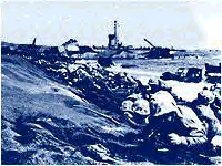BATTLE OF THE WEEK
The Battle of Iwo Jima

D-DAY Feb. 19, 1945, 8:30AM
The Battle of Iwo Jima was one of the bloodiest and most costly battles in the Pacific Theater during World War II. The battle began on February 19, 1945 when a large force of U.S. Marines assaulted the beaches at 8:30 AM. Just hours before the attack, 110 heavy bombers attacked the island and U.S. Naval ships bombarded the island with their big guns. The order "Land the Landing Force" signaled the first wave of Marines who landed on the loose volcanic ash beaches that were targeted by deadly Japanese guns. The volcanic ash on the beaches prevented the Marines from digging foxholes so they were exposed to enemy fire during the whole operation. Because the islandís total area was 7.5 miles, its 100,000 fighting men made it the most populated place on earth for 36 days.
Mt. Suribachi, the volcanic cone on the island, was the highest point and allowed the Japanese guns to zero in on American forces. Blockhouses and pillboxes covered the landing area and machine guns were trained on the beaches so the Marines were always in range of the Japanese guns. The goal of the U.S. Marines was to secure a beachhead and capture Mt. Suribachi because it was an important defense position and served as the command post for the Japanese. All of the Japanese were either dug in to the sides of Mt. Suribachi or occupied pillboxes so the Marines rarely saw a live Japanese soldier. Because it was too costly to sent valuable men into the Japanese strongholds, the Marines used the flamethrower to burn the Japanese soldiers out of hiding. One of the most famous pictures of World War II was the picture of U.S. Marines hoisting up the American flag on Mt. Suribachi. The mountain was officially captured by the Marines on February 23rd but it took several weeks until all Japanese resistance ceased on the island on March 24, 1945. After fighting for almost a month, the Marines officially declared that the campaign was over on March 16, 1945. More than 6,000 U.S. Marines lost their lives in service to our country and Japanese losses were estimated around 20,000. The capture of Iwo Jima allowed the United States to use it as an airfield to bomb Japan with medium-bombers. Today, the island is owned by Japan and is uninhabited although veterans are allowed to visit the memorial there with special permission.

U.S. MARINES ON TOP OF MT. SURIBACHI SHORTLY AFTER FEB. 23RD